Gluten Free Ramen Noodle Recipe
If you love ramen, but you’re on a gluten free diet you’ll love this Gluten Free Ramen Noodle Soup Recipe! This easy soup recipe is done in thirty minutes and makes great lunches for the go!
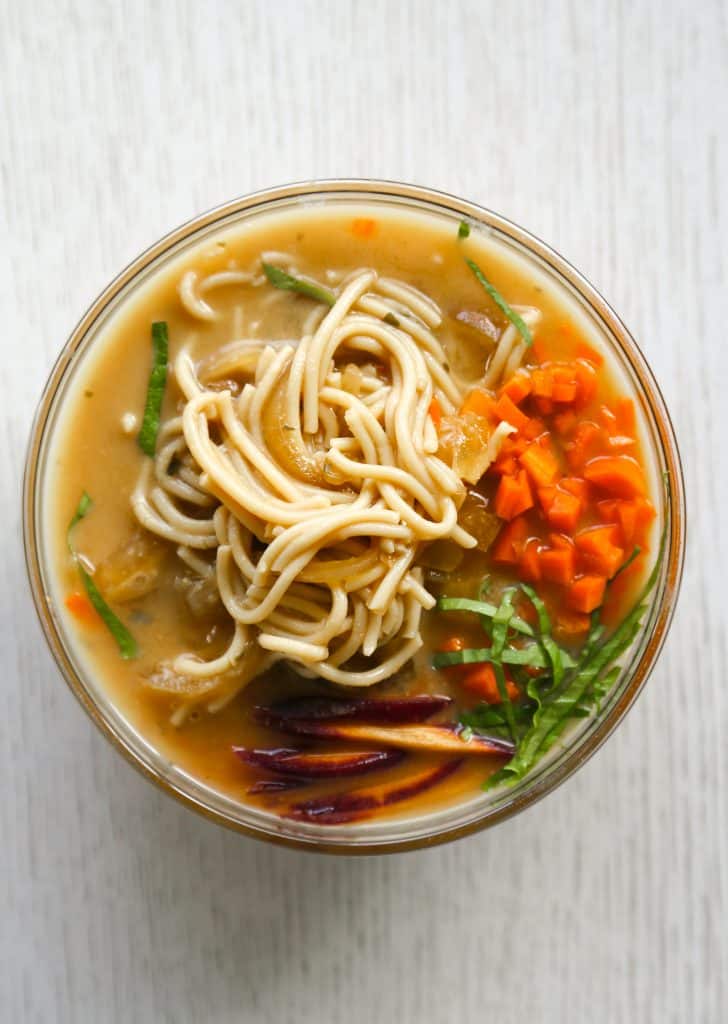
This post may contain affiliate links. As an Amazon Associate I earn from qualifying purchases at no cost to you. See my Affiliate Disclosure to read my policy and more about affiliate links.
Table of Contents
- Why You’ll Love This Gluten Free Ramen Recipe
- What is Ramen?
- Is Ramen Gluten Free?
- Ingredients And Substitutions For Gluten Free Ramen Noodle Recipe
- Ingredient Substitutions for this Gluten Free Ramen Recipe:
- How to Make This Gluten Free Ramen Noodle Recipe
- Are Ramen Noodles Gluten Free?
- How to Store and Serve Gluten Free Ramen Noodle Soup
- More Gluten Free Soup Recipes to Try
- Are All Ramen Noodles Gluten Free
- What are the Best Gluten Free Ramen Noodles?
- What other noodles can I use?
- What are Low Carb or Grain Free Ramen Noodle Substitutions
- Is Ramen Soup Supposed to be Salty?
- Can I Add Protein to Gluten Free Ramen Noodle Soup
- Healthier brands of gluten free instant ramen noodle soup
- Why is Ramen Not Gluten Free?
- Can You Buy Gluten Free Ramen Noodles?
- What if you Can’t Find Gluten Free Ramen?
- Is The Seasoning Packet in Ramen Gluten Free?
- Can You Make Gluten Free Ramen Noodle Soup Ahead?
- How to Reheat Gluten Free Ramen Noodle Soup
- GF Ramen Recipe Variations
- Can you Refreeze Miso Soup?
- Are Vermicelli Noodles Gluten Free?
- Common Questions and Answers
- Is Mirin Gluten Free?
Table of Contents
- Why You’ll Love This Gluten Free Ramen Recipe
- What is Ramen?
- Is Ramen Gluten Free?
- Ingredients And Substitutions For Gluten Free Ramen Noodle Recipe
- Ingredient Substitutions for this Gluten Free Ramen Recipe:
- How to Make This Gluten Free Ramen Noodle Recipe
- Are Ramen Noodles Gluten Free?
- How to Store and Serve Gluten Free Ramen Noodle Soup
- More Gluten Free Soup Recipes to Try
- Are All Ramen Noodles Gluten Free
- What are the Best Gluten Free Ramen Noodles?
- What other noodles can I use?
- What are Low Carb or Grain Free Ramen Noodle Substitutions
- Is Ramen Soup Supposed to be Salty?
- Can I Add Protein to Gluten Free Ramen Noodle Soup
- Healthier brands of gluten free instant ramen noodle soup
- Why is Ramen Not Gluten Free?
- Can You Buy Gluten Free Ramen Noodles?
- What if you Can’t Find Gluten Free Ramen?
- Is The Seasoning Packet in Ramen Gluten Free?
- Can You Make Gluten Free Ramen Noodle Soup Ahead?
- How to Reheat Gluten Free Ramen Noodle Soup
- GF Ramen Recipe Variations
- Can you Refreeze Miso Soup?
- Are Vermicelli Noodles Gluten Free?
- Common Questions and Answers
- Is Mirin Gluten Free?
GF Miso ramen was inspired by my favorite Miso Soup Recipe that I’ve been making every week since 2015. I learned this recipe from my macrobiotic teacher at the Natural Gourmet Institute, Elliot Prag. Chef Pragg (an accomplished macrobiotic chef and author) learned this recipe from the Kushi Institute. Which was the most well respected macrobiotic healing institution of its time.
Since my daughter loves noodles, I wanted to make a vegan and gluten free version with a meatier flavor (which is typical of ramen) with gluten free noodles. I don’t like noodles but I always add low carb kelp noodles for myself.
When I was testing this recipe I brought it over to my mother’s house. She was sick at the time and I received TONS of positive feedback. I know you’ll love it.
Why You’ll Love This Gluten Free Ramen Recipe
- Quick and Easy To Make
- Gluten Free
- Vegan
- Paleo Friendly
- Plant Based
- Great for Work and School Lunches
- Can be Low Carb and Keto Friendly
What is Ramen?
Ramen is a popular Japanese noodle soup. There are literally 1000’s of variations of ramen but all ramen noodle soup consists of a broth, spaghetti like noodles and toppings. The toppings can consist of vegetables, eggs, fish or seafood. Some common vegetables you’ll find in soup consist of bean sprouts, bok choy, carrots, onions, scallions etc.
Is Ramen Gluten Free?
No, traditional ramen noodles are not gluten free since their main ingredient is wheat flour. The broth is usually full of gluten as well since it contains soy sauce which is made from wheat. Generally speaking, ramen noodle soup is one of the worst meals someone on a gluten free diet could eat. It’s right up there with wheat based breads and cakes!
Ingredients And Substitutions For Gluten Free Ramen Noodle Recipe
- Toasted Sesame Oil
- Kombu
- Dried Shiitake Mushrooms
- Onion
- Garlic Cloves
- Carrots
- Celery
- Gluten Free Tamari
- Mellow White Miso
- Lemon
- Nutritional Yeast
- Dried Cilantro
- Gluten Free Ramen Noodles
Ingredient Substitutions for this Gluten Free Ramen Recipe:
- Toasted Sesame Oil: Regular sesame oil or olive oil will also work well for this soup.
- Nutritional Yeast: You can use bullion cubes instead.
- Carrots: If you prefer not to eat carrots, try using daikon radish instead.
- Gluten Free Tamari: You can use gluten free soy sauce instead.
- Lemon Juice or Brown Rice Vinegar: You need to use an acid for this recipe, but you can use apple cider vinegar if you don’t have lemon juice or brown rice vinegar.
- Gluten Free Ramen Noodles: Other types of noodles that are gluten free including rice, kelp, soba, gluten free spaghetti, shirataki, vegetable or glass noodles.
How to Make This Gluten Free Ramen Noodle Recipe
- In a medium sized pot heat the oil. Add the kombu, mushrooms, onion and garlic. Sauté over medium low heat until the onions are translucent. Then, add the carrots and celery, continue to sauté for another few minutes.
- Add tamari, miso paste, and water. Whisk until the miso is dissolved. Add some lemon juice, nutritional yeast and cilantro. Bring the soup to a simmer for 10-15 minutes. Add the gluten free noodles and cook for another four minutes. Stir to break apart the noodles. Serve immediately.
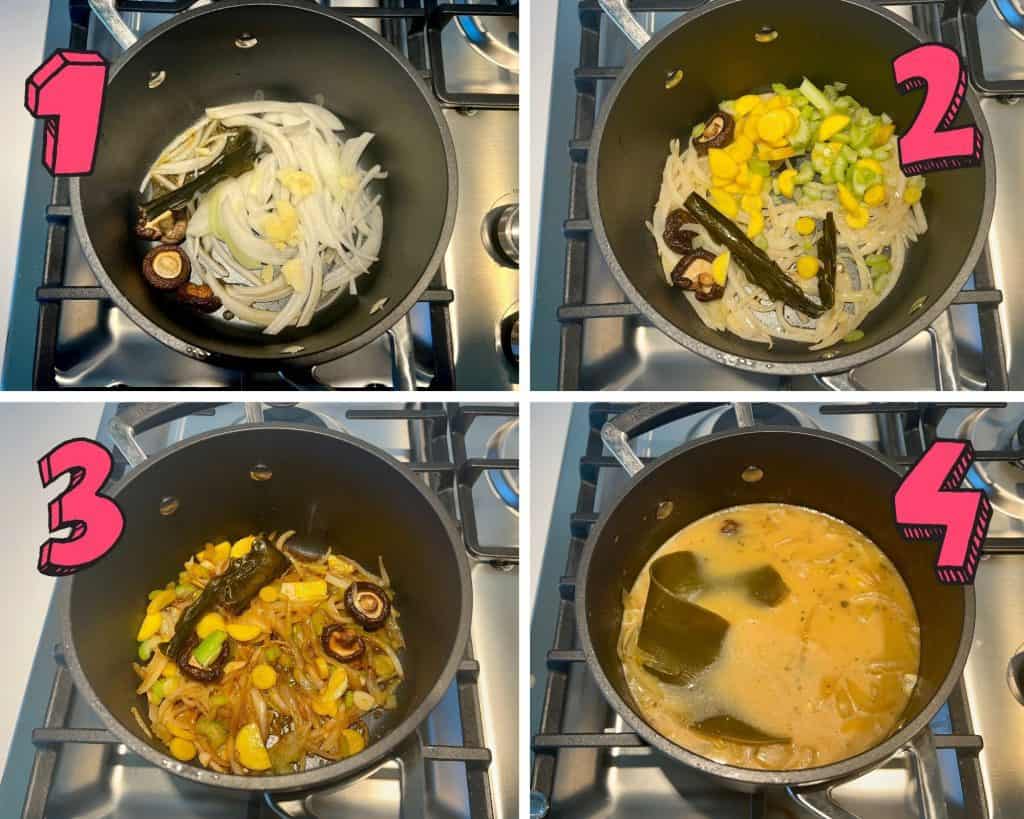
Are Ramen Noodles Gluten Free?
No, traditional ramen noodles are not gluten free since their main ingredient is wheat flour. The broth is usually full of gluten as well since it contains soy sauce which is made from wheat. Generally speaking, ramen noodle soup is one of the worst meals someone on a gluten free diet could eat. It’s right up there with wheat based breads and cakes!
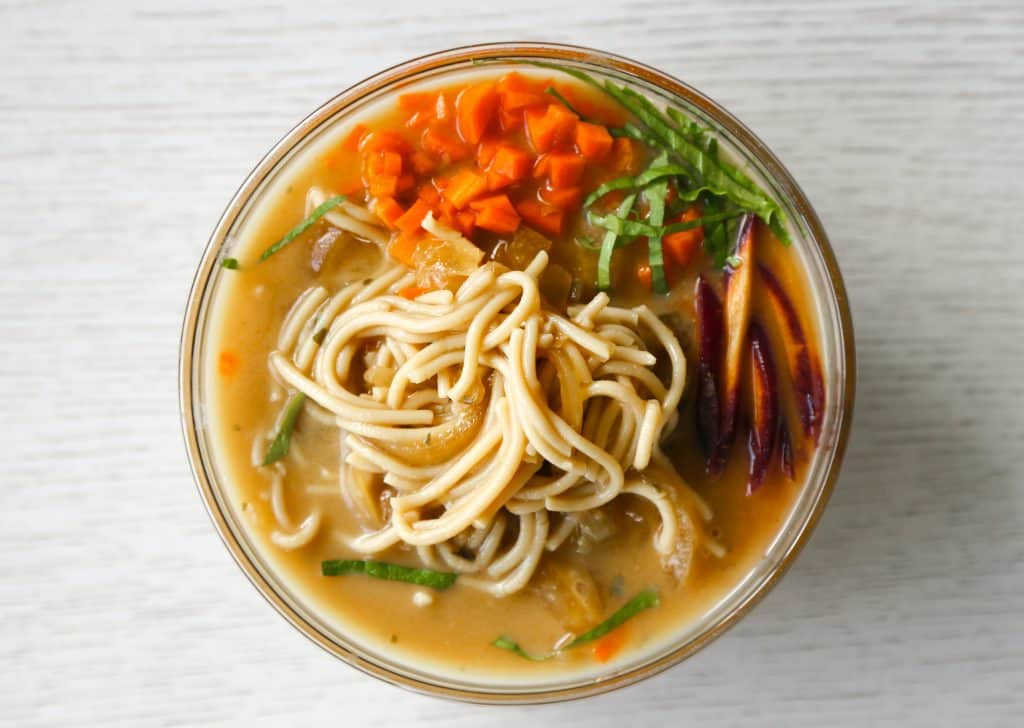
How to Store and Serve Gluten Free Ramen Noodle Soup
Gluten Free Ramen Noodle Soup is so versatile you can serve it many ways. My favorite way is to put it in a thermos to eat as a lunch on the go.
Ramen is great for people who like to meal prep because you can make the broth in advance and store it in individual servings in a a thermos or mason jar. When you’re ready to eat the ramen simply heat up the water and drop a “cake” of gluten free ramen noodles in the jar and let it steep for 3 minutes. The noodles will soften and then you can enjoy fresh ramen for lunch!
If you want to make the whole soup in advance you can do that as well. The noodles will retain their structure for up to 5 days in the fridge. You can cook this recipe once and get 4 lunches out of it.
Change up ramen noodle soup by adding different types of vegetables or protein like:
- Chicken
- Bok Choy
- Poached Egg
- Shrimp
- Spinach
More Gluten Free Soup Recipes to Try
- Gluten Free Miso Soup
- Gluten Free Mushroom Soup
- Gluten Free Tomato Soup
- Carrot Sweet Potato Soup
- Broccoli Cheddar Soup
- Pea Soup With Thyme
- Curried Cauliflower Soup
Are All Ramen Noodles Gluten Free
No, traditional ramen noodles are not gluten free since their main ingredient is wheat flour. The broth is usually full of gluten as well since it’s usually made with soy sauce, which is made from wheat. Ramen noodle soup is one of the worst meals someone on a gluten free diet could eat because the broth and noodles are filled with tons of gluten.
But it’s so delicious! So if you want to enjoy ramen without ingesting gluten, fear not! Just because you’re gluten free doesn’t mean you can’t enjoy gluten free ramen noodles. There are plenty of gluten free noodles on the market along with different types of GF broth you can make. Including the recipe below!
If you make a miso based broth and use gluten free Tamari or nutritional yeast to build umami flavor you don’t need soy sauce.
What are the Best Gluten Free Ramen Noodles?
The best gluten free ramen noodles for soup are Organic Millet & Brown Rice Ramen by Lotus Foods. The millet flour gives the noodles good structure, they’re soft but don’t get mushy. I couldn’t even tell the difference between these and regular ramen noodles.
What other noodles can I use?
While I love Gluten Free Ramen Noodles by Lotus there are still plenty of other types of noodles you can use that are gluten free if you don’t have gluten free ramen noodles:
- Rice Noodles
- Kelp Noodles
- Soba Noodles (made from buckwheat flour)
- Gluten Free Spaghetti Pasta
- Shirataki Noodles
- Vegetable Noodles
- Glass Noodles (made from mung beans)
What are Low Carb or Grain Free Ramen Noodle Substitutions
While gluten free ramen noodles are great for those following a gluten free diet. What if you’re eating low carb and gluten free because you’re following a diet like Keto? There are still plenty of gluten free ramen noodle alternatives you can try that are also low in carbs.
Kelp Noodles: are low carb noodles made from kelp! They’re commonly used in Korean and vegan cooking.
Shirataki Noodles: Shirataki noodles are generally considered allergy free since they’re made from yams and contain no grain, gluten, nuts or soy.
Vegetable Noodles: Vegetable noodles are a great low carb alternative to rice based gluten free ramen noodles.
Is Ramen Soup Supposed to be Salty?
Most ramen soup recipes are made with ingredients that are high in sodium like soy sauce, bouillon cubes and miso paste. So yes ramen is supposed to taste salty. But it shouldn’t be so salty that it doesn’t taste good.

Ramen broth is hard to make because it takes a lot of time and ingredients to a build good flavor base. Most quick ramen recipes use tons of salt to build the flavor up instead of using other ingredients like vegetables and nutritional yeast to create authentic umami flavor. This is especially true for instant ramen which is very high in sodium.
My gluten free ramen noodle soup recipe is a little salty but it has a lot of umami flavor from the nutritional yeast and vegetables to help balance out the sodium.
If your ramen noodle soup is too salty you can add more water to dilute the sodium and add more acid like vinegar or lemon juice.
Can I Add Protein to Gluten Free Ramen Noodle Soup
Yes! Adding protein to gluten free ramen noodle soup is a great way to make it a more filling main course. Plenty of different types of protein work well with ramen including eggs, chicken and sea food.
If you want to add protein to gluten free ramen soup while keeping it vegan you can add tofu or beans to it. Tofu and beans are high in protein and taste great in ramen noodle soup.
Types of protein that go well with gluten free ramen noodle soup:
- Tofu
- Hard Boiled Eggs
- Beans
- Chicken
- Salmon
- Shrimp
Healthier brands of gluten free instant ramen noodle soup
It’s always better to make your own homemade gluten free ramen noodle soup. It’s easy and takes only a few minutes. But there are days when we are in a rush and just need something cheap, fast and filling. For busy days where you just need to grab a bowl of instant soup lean into these healthier alternatives.
Red Miso Rice Ramen Noodle Soup Cup by Lotus Foods
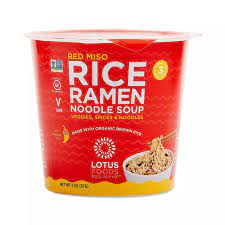
These noodles are vegan, gluten free, and free from any harmful preservatives.
Ingredients: Organic brown rice flour, red miso powder (cultured soybeans, rice, salt), tamari powder (soybeans, sea salt), salt, onion powder, wakame, garlic powder, ginger powder, sugar, dried parsley, chili flakes, chili powder.
Dr. McDougall’s Rice Noodle Gluten Free Soup Sesame Chicken
Dr. McDougall’s sells many different flavors of gluten free instant ramen noodle soup.
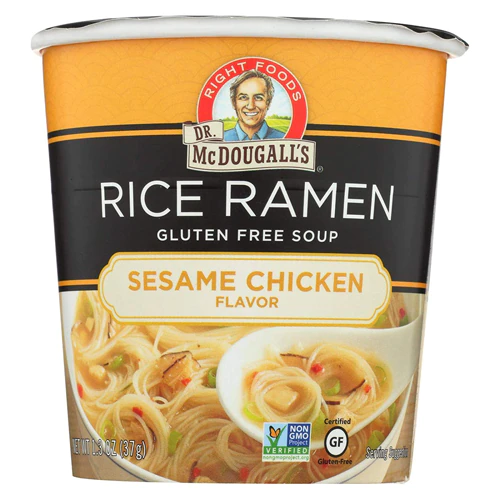
Ingredients: Rice noodles* (rice, tapioca starch), yeast extract, organic cane sugar, wheat free soy sauce (soybeans, salt)*, garlic*, potato starch, sesame flour, natural flavor, organic vinegar*, mushroom*, red bell pepper*, spices, green onion*, citric acid, organic caramel color. *Dried.*
Why is Ramen Not Gluten Free?
Ramen isn’t gluten free for a few reasons. The main ingredient in ramen noodle soup are wheat based ramen noodles. Since ramen noodles are
Can You Buy Gluten Free Ramen Noodles?
Yes there are plenty of brands of gluten free ramen noodles you can buy. Not only are there lots of different kinds of gluten free ramen noodles but they are made from many different ingredients. You can get buckwheat noodles and even noodles that are made without grains! Thats right. Some gluten free ramen noodle options are made from vegetables, tofu and seaweed! Here are my favorite types of gluten free ramen noodle alternatives.
- Kelp Noodles
- Shiratake Noodles
- Vegetable Noodles – Vegetable noodles can be made of sweet potatoes, beets or other vegetables.
- Rice Noodles – Rice noodles are naturally gluten free.
- Buckwheat Noodles – Buckwheat is naturally gluten free and has a similar texture to regular wheat noodles.
What if you Can’t Find Gluten Free Ramen?
If you’re shopping for gluten free ramen noodles in Target, Walmart, Publix, Whole Foods or Shop Rite but you can’t find any. Don’t worry because you can use gluten free spaghetti instead! Spaghetti noodles are long and thin like ramen.
Is The Seasoning Packet in Ramen Gluten Free?
The seasoning packet in most brands of ramen noodle soup are not gluten free because they contain soy sauce as one of the ingredients. Unless you buy ramen that’s labeled gluten free you should assume that it’s flavored with soy sauce which is derived from wheat.
All soy sauce has gluten in it unless it’s labeled gluten free. If you’re looking for a good gluten-free substitute for soy sauce you can use tamari.
Can You Make Gluten Free Ramen Noodle Soup Ahead?
You can make ramen noodle soup ahead of time. I would just suggest storing the noodles and the broth separately. You can make ramen noodle soup up to 4 days ahead of time.
The best way to make ramen noodle soup ahead is to make the broth. Before you’re ready to serve the soup heat the broth up on the stovetop. In the last five minutes of cooking add the ramen noodles in. That way the soup tastes fresh and the ramen won’t be mushy!
How to Reheat Gluten Free Ramen Noodle Soup
The best way to reheat ramen soup is to warm it up on the stove top in a small pot. If you follow the instructions above on how to freeze your miso soup by breaking it down into smaller portions…
- Thaw out the ramen noodle soup in the fridge, under cold water, or the microwave.
- Place the soup in a small sauce pan and cook it over low heat and stir every few minutes.
- Within 7 minutes the soup will start to steam. This means it’s hot enough to eat!
GF Ramen Recipe Variations
- Add shrimp. In the last five minutes of cooking add raw, deveined shrimp to add protein.
- Add chicken. You can add chicken with the vegetables to make the soup more filling.
- Add an egg. In the last few minutes of cooking crack a raw egg into the soup. The hot broth will cook the egg.
Can you Refreeze Miso Soup?
No, it is not safe to refreeze ramen soup. The soup can get damaged during the freezing and reheating process. Not to mention that refreezing soup exposes it to harmful bacteria growth which will lead to food borne illnesses.
Are Vermicelli Noodles Gluten Free?
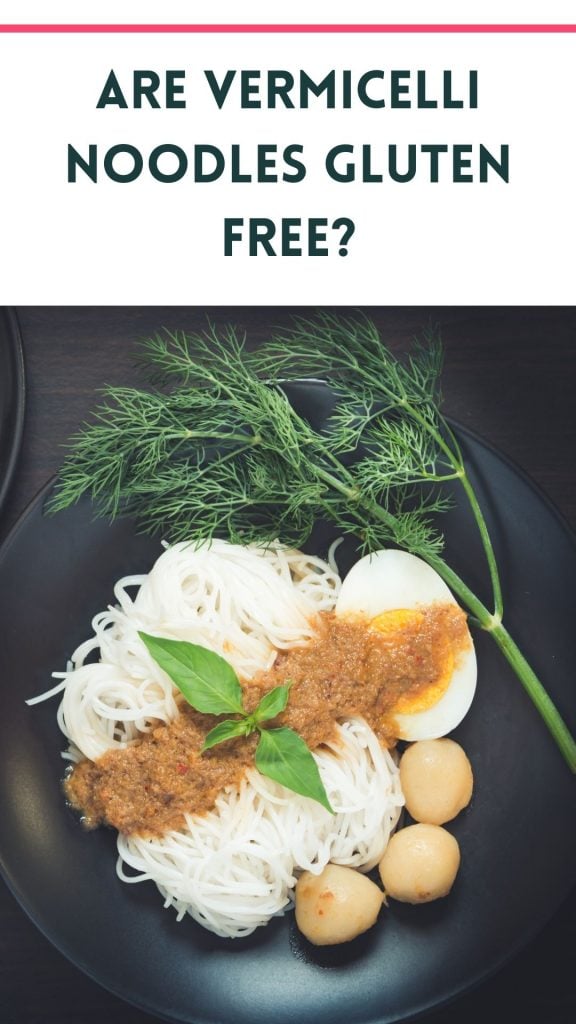
Technically the word vermicelli refers to the width of the noodle and not the flour used to make it. Vermicelli made from ingredients like buckwheat and rice are gluten free, whereas wheat based vermicelli isn’t.
So Vietnamese style vermicelli noodles are made from ground rice flour and are gluten free while Italian vermicelli noodles are made from wheat flour and are therefore full of gluten!
Common Questions and Answers
There are many different types of ramen broth but generally speaking ramen broth is made up of chicken or pork stock combined with vegetables, miso, shoyu, seafood, Kombu and meat. Sometimes a sauce called tare is used to flavor the broth as well.
The combination of stock and other ingredients are broken down into four main flavors called Miso, Shoyu, Kare, and Shio. This information was sourced from wikipedia.
Yes! Ramen can be made gluten free by avoiding ingredients that contain wheat and replacing them with gluten free items with a similar taste. For example, instead of using soy sauce you can use gluten free Tamari for the broth and for the noodles you can use gluten free ramen noodles or another type of gluten free noodle like soba, buckwheat, vegetable, glass, kelp or rice noodles.
Instead of regular ramen noodles you can use gluten free ramen noodles that are made with rice flour or millet flower. You can also use other types of gluten free noodles that are commonly used in Asian cuisine including rice, kelp, soba, gluten free spaghetti, shirataki, vegetable or glass noodles.
Traditional miso ramen is not gluten free. But miso itself is gluten free so if the miso ramen broth doesn’t contain soy sauce or other wheat ingredients then it is also gluten free.
It’s best to ask for a list of ingredients before assuming miso ramen is gluten free. The miso ramen broth I made for this gluten free miso soup is gluten free because it doesn’t contain soy sauce or any other wheat based ingredients.
Is Mirin Gluten Free?
Mirin is another common ingredient found in Japanese cooking. So is mirin gluten free? Well, it depends on which kind you buy because not all mirin is created equally. Authentic mirin is naturally gluten free since it is made entirely from rice. However, mirin is time consuming to produce which drives the cost up. Since mirin is a popular ingredient, companies started making synthetic mirin to increase production and lower the price.
This synthetic mirin (known as Aji Mirin) is not always gluten free because it can contain ingredients that contain gluten. Such as, glucose syrup, water, alcohol, corn syrup, and salt.
Aji Mirin can have additives in it that contain gluten. So if you’re on a gluten free diet the best thing to do is to buy authentic Hon Mirin and to stay away from Aji Mirin.
Gluten Free Ramen Noodle Soup Web Story
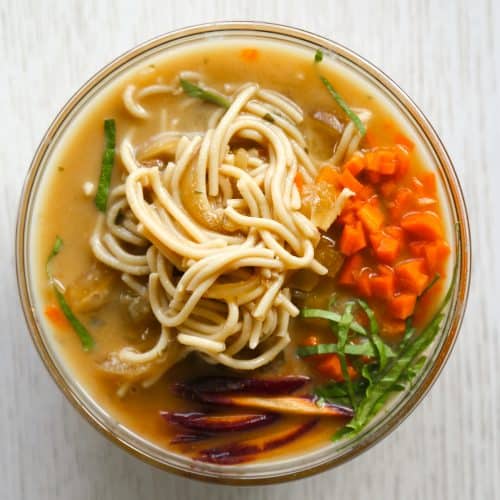
Gluten Free Ramen
Equipment
- Soup Pot
- Cutting Board
Ingredients
- 2 tbsp Toasted Sesame Oil
- 1 piece Kombu
- 3 Dried Shiitake Mushrooms
- 1 Onion saute slice
- 2 cloves Garlic thinly slice
- 1-2 Carrots thinly slice
- 1 stalk Celery thinly slice
- 1/4 C Gluten Free Tamari
- 1/4 C Mellow White Miso
- 4 C Water
- 1 Lemon juiced
- 1/4 C Nutritional Yeast
- 1 tbsp Dried Cilantro
- 1 cake Gluten Free Ramen Noodles
Instructions
- In a medium sized pot heat oil. Add kombu, mushrooms, onion and garlic. Sauté until the onion is translucent. Add the carrots and celery and sauté for another few minutes.
Video
Nutrition

FREE 7 Day Gluten Free Meal Plan
A meal plan designed to jump start whole body healing and support digestive health……
…And get the latest recipes!

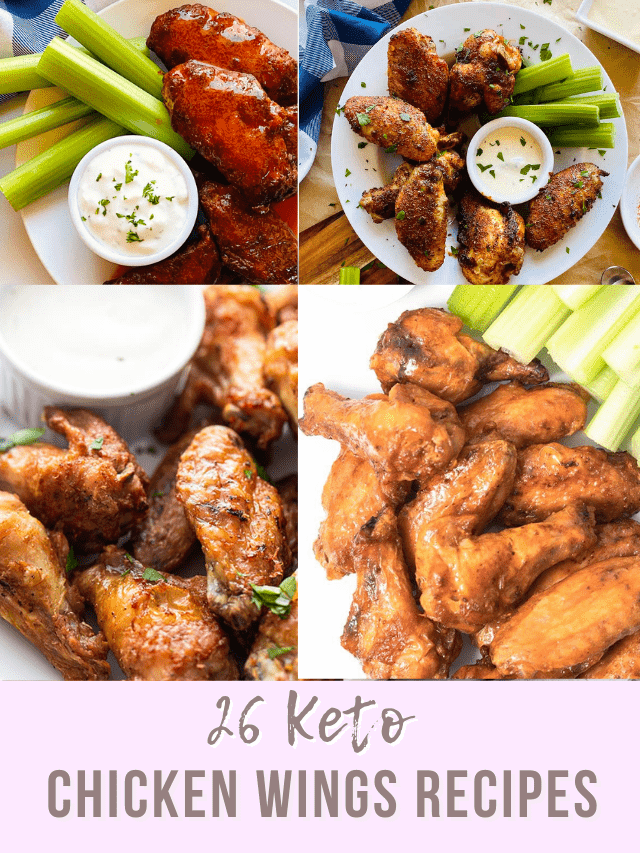


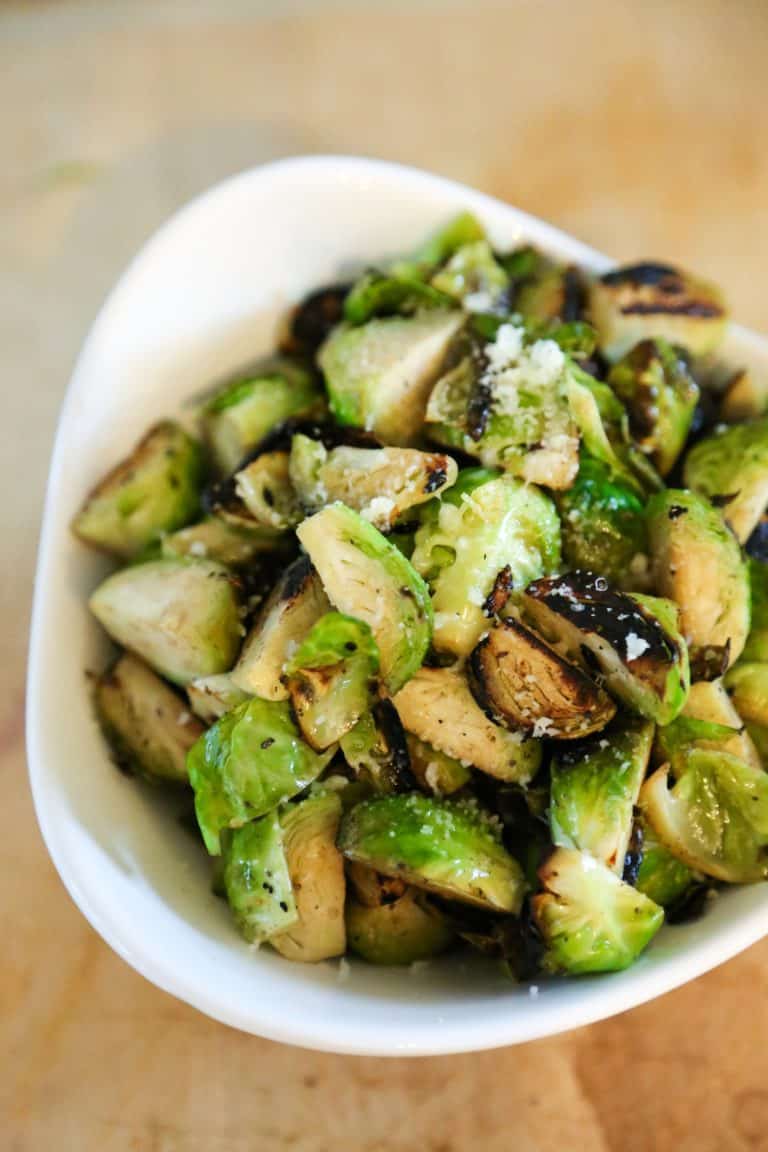
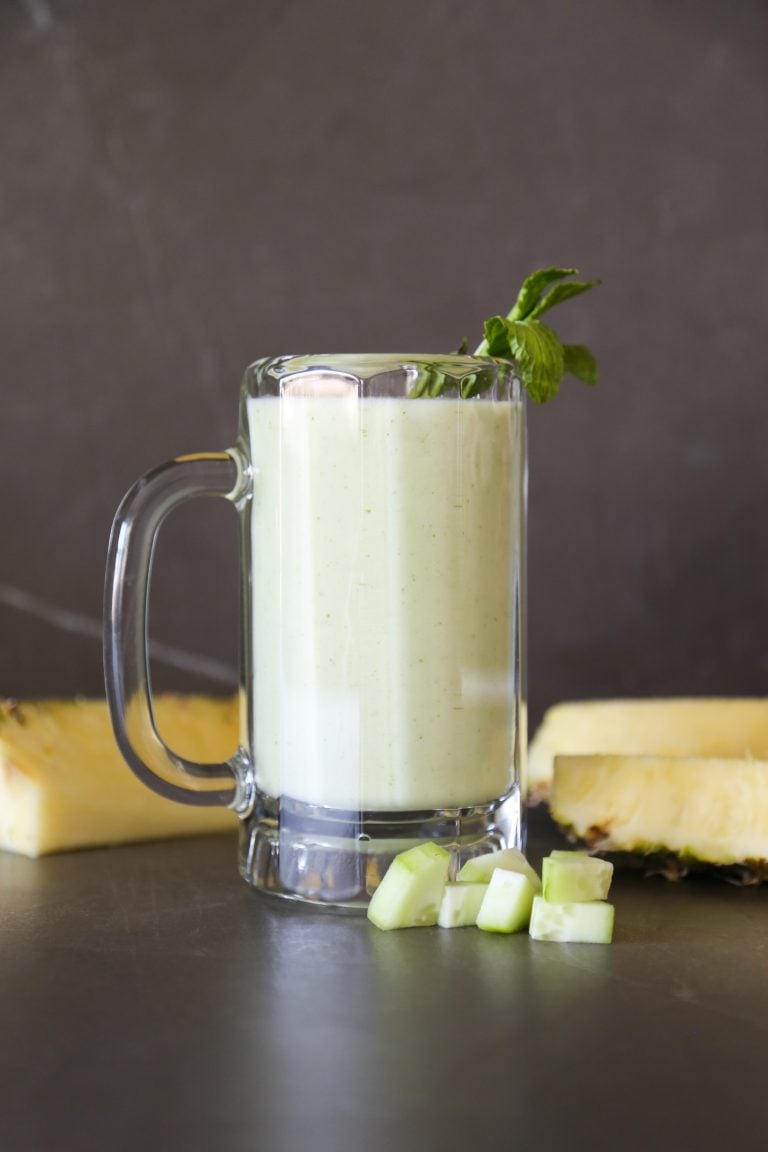
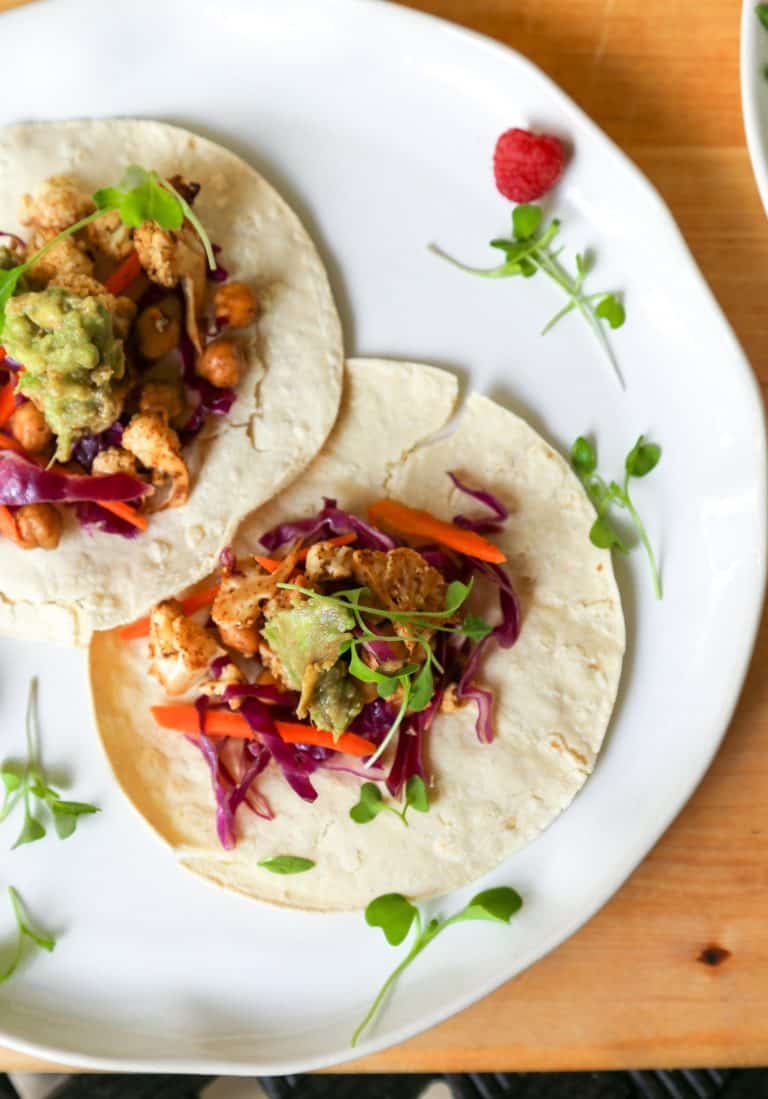
This is awesome! So good, and a great option for those who live gluten-free!
Hey Patricia! Thank you so much I’m glad you enjoyed it.
I miss having ramen from NYC and used to eat it all the time, so happy I found this recipe. I can’t wait to make it again. Thanks to the chef for sharing!
Hey Boca Food Queen! Thank you so much! I hope you like it. I just moved to boca so we’re neighbors. If you like this recipe the miso soup on my site is really my all time favorite soup. It’s similar to the ramen.
This recipe along with many of the other recipes i have tried are right on point. Recipes are easy to follow with a delicious and healthy
Outcome.
2022 will be a Healthy year!!
Fern, thank you so much! I’m so glad you’re enjoyed this recipe and other ones on the blog as well! Happy new year!
Most Ramen soups have too much sodium so I cannot eat them. This recipe is so delicious and easy to make.
Hey Jill! Thanks you! The veggies and nutritional yeast ad a ton of flavor to this miso style broth so you don’t need as much salt!
Soooooo good!!!
Molly, I’m so glad you enjoyed the soup!
Delicious!!!! I’m not much of a cook but this was very easy to make!! I’ll be making this again this week!!!
Hey Marci! Thank you so much for the feedback! I’m excited that ramen noodle soup is going to be a household staple!
I’m serving it at my New Year’s Eve dinner in my living room tonight
That sounds amazing! Thank you Robin. Let me know how it turns out.
I used to love Ramen noodle soup. This is definitely a healthier delicious alternative!
Easy to follow abs so delicious! I will definitely be making This often!
Soooo good. This will be a menu regular at our house.
Thanks Linda! I’m glad you like the recipe.